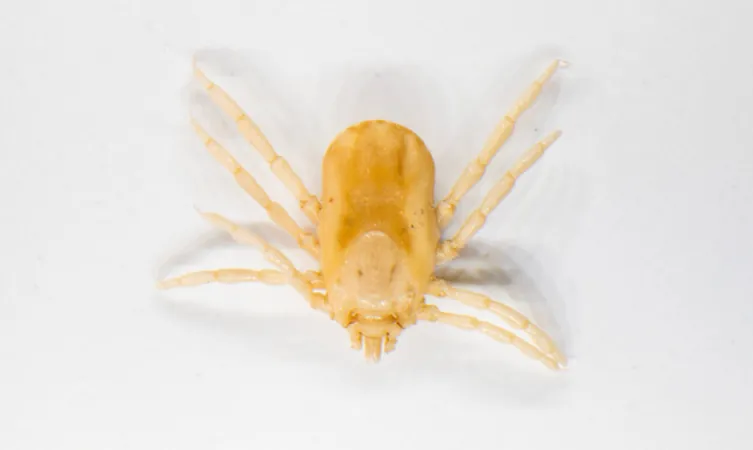
Revolutionary Genetic Tools on the Horizon to Tackle Cattle Fever Ticks!
2024-11-27
Author: Yu
Revolutionary Genetic Tools on the Horizon to Tackle Cattle Fever Ticks!
A groundbreaking collaboration between the Texas A&M Department of Entomology and the U.S. Department of Agriculture (USDA) is paving the way for potential genetic methods to combat disease-spreading ticks, particularly the notorious cattle fever ticks that threaten livestock.
In a recent study published in the prestigious journal G3: Genes, Genomes, Genetics, Jason Tidwell, a committed graduate student from Texas A&M and a microbiologist at the USDA's Agricultural Research Service Cattle Fever Tick Research Unit, has made significant headway in identifying genetic markers related to sex determination in Rhipicephalus microplus, one of the two invasive species of cattle fever ticks found in northern Mexico. These findings could revolutionize strategies for controlling these persistent parasites that historically plagued the U.S. cattle industry.
Unveiling the Secrets of Tick Biology
“Tidwell's work exemplifies how understanding an unknown biological facet of pests can lead to innovative control measures,” stated Dr. Kimberly Lohmeyer, director at the Knipling-Bushland U.S. Livestock Insects Research Laboratory. She emphasized that such breakthroughs could soon translate into practical solutions for managing the threat posed by ticks capable of transmitting bovine babesiosis—known as Texas cattle fever.
Dr. Pete Teel from Texas A&M AgriLife Research underscored the importance of unraveling the mechanisms of sex determination, stating that this knowledge is vital for developing genetic pest control strategies. The research lays the foundation for techniques similar to those successfully used against other pests, such as the primary screwworm and various mosquito species, potentially leading to a groundbreaking overhaul in livestock tick management.
The Battle Against Bovine Babesiosis
Established in 1906, the Cattle Fever Tick Eradication Program represents a united front by the USDA and the Texas Animal Health Commission to keep these disease-carrying ticks at bay. This program has successfully eradicated cattle fever ticks in all but a permanent quarantine zone in South Texas, preventing the pathogens responsible for bovine babesiosis from spreading across the U.S.
“What we know is straightforward: eliminate the ticks, and you significantly reduce the risk of disease,” remarked Teel. Currently, the battle relies heavily on chemical tick controls through acaricides, but with ticks developing increased resistance to these pesticides, fresh approaches are needed. Tidwell's research may offer the avenue needed for change.
A Game-Changer for Vector Control
One proposed method involves manipulating the sex ratios of tick populations in the environment to curtail their reproduction and ultimately crash their numbers. This innovative genetic tactic has shown promise in controlling Aedes aegypti mosquitoes, vectors of dangerous diseases including West Nile virus, Dengue, and Zika.
Moreover, Tidwell's revolutionary findings could extend beyond cattle as they may influence controls against tick-borne diseases affecting humans, such as Lyme disease.
As Dr. Aaron Tarone, Tidwell's co-advisor, emphasized, for any new control tools to be effective, they must be logistically viable, environmentally conscious, and economically sustainable. However, the future looks bright as researchers plan to analyze the genomes of tick populations from both Texas and Mexico to map out their genetic variation.
With technological advancements in genomics, the potential to counteract these formidable threats to both animal and human health is not merely a dream but an approaching reality. The scientific community awaits eagerly to uncover how these genetic tools can reshape disease management strategies in the looming battle against ticks.
 Brasil (PT)
Brasil (PT)
 Canada (EN)
Canada (EN)
 Chile (ES)
Chile (ES)
 España (ES)
España (ES)
 France (FR)
France (FR)
 Hong Kong (EN)
Hong Kong (EN)
 Italia (IT)
Italia (IT)
 日本 (JA)
日本 (JA)
 Magyarország (HU)
Magyarország (HU)
 Norge (NO)
Norge (NO)
 Polska (PL)
Polska (PL)
 Schweiz (DE)
Schweiz (DE)
 Singapore (EN)
Singapore (EN)
 Sverige (SV)
Sverige (SV)
 Suomi (FI)
Suomi (FI)
 Türkiye (TR)
Türkiye (TR)